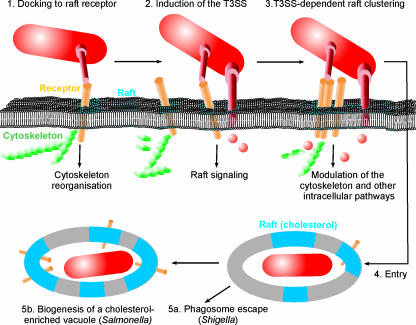FIG. 7.
Cholesterol and lipid rafts as triggers of type III secretion and targets of effectors. (1) The initial contact of bacteria with cholesterol-rich membrane microdomains is mediated by receptors, which partition to rafts. Receptor binding might already induce raft signaling, e.g., trigger the reorganization of the cytoskeleton. (2) Raft contact is followed by the cholesterol-dependent induction of effector protein secretion. (3) Receptor binding and effector secretion lead to the clustering of rafts and the subsequent uptake of the bacteria as well as the activation of other signaling pathways. (4) After uptake, the bacteria reside in a raft-containing vacuole, which is lysed (5a) or modified to create a replication-permissive niche (5b). Modification of the vacuole leads to a further enrichment of rafts (cholesterol), thus permitting bacterial manipulation of raft-associated signaling pathways.

